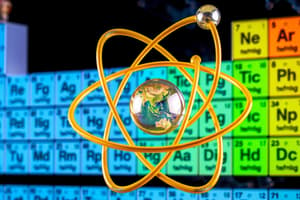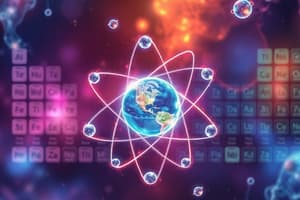Podcast
Questions and Answers
What is the basic unit of matter?
What is the basic unit of matter?
- Atom (correct)
- Element
- Compound
- Molecule
Which of the following describes Ionic Bonds?
Which of the following describes Ionic Bonds?
- A cloud of electrons surrounding a nucleus
- Formation of a molecule through covalent bonds
- Sharing of electrons between atoms
- Transfer of electrons creating charged ions (correct)
What is the term for substances formed as a result of a chemical reaction?
What is the term for substances formed as a result of a chemical reaction?
- Products (correct)
- Compounds
- Solutions
- Reagents
Which of the following states of matter has particles that are tightly packed and have a definite shape?
Which of the following states of matter has particles that are tightly packed and have a definite shape?
What is the function of the pH scale?
What is the function of the pH scale?
What is the simplest form of matter that cannot be broken down further?
What is the simplest form of matter that cannot be broken down further?
Which type of reaction involves two or more substances combining to create a new compound?
Which type of reaction involves two or more substances combining to create a new compound?
What describes the properties of elements within the same group of the periodic table?
What describes the properties of elements within the same group of the periodic table?
Study Notes
Basic Concepts of Chemistry
- Matter: Anything that has mass and occupies space.
- Elements: Simplest forms of matter; cannot be broken down into simpler substances. Examples: hydrogen (H), oxygen (O).
- Compounds: Substances formed when two or more elements chemically bond. Example: water (H2O).
Atomic Structure
- Atoms: Basic unit of matter, consisting of:
- Protons: Positively charged particles in the nucleus.
- Neutrons: Neutral particles in the nucleus.
- Electrons: Negatively charged particles orbiting the nucleus.
- Atomic Number: Number of protons in an atom; defines the element.
- Mass Number: Total number of protons and neutrons in an atom.
Periodic Table
- Groups: Vertical columns; elements have similar chemical properties.
- Periods: Horizontal rows; properties change progressively across a period.
- Metals, Nonmetals, and Metalloids: Classification based on properties.
Chemical Bonds
- Ionic Bonds: Formed when electrons are transferred from one atom to another, creating charged ions.
- Covalent Bonds: Involve the sharing of electrons between atoms.
- Metallic Bonds: A 'sea of electrons' shared among metal atoms, leading to conductivity and malleability.
Chemical Reactions
- Reactants: Substances that undergo change during a reaction.
- Products: Substances formed as a result of the reaction.
- Types of Reactions:
- Synthesis: Two or more substances combine to form a new compound.
- Decomposition: A compound breaks down into simpler substances.
- Single Replacement: An element replaces another in a compound.
- Double Replacement: Exchange of ions between two compounds.
- Combustion: Reaction with oxygen, producing heat and light.
States of Matter
- Solid: Definite shape and volume; particles closely packed.
- Liquid: Definite volume but takes the shape of its container; particles less tightly packed than in solids.
- Gas: No definite shape or volume; particles are far apart and move freely.
Acids and Bases
- Acids: Substances that release hydrogen ions (H+) in solution (e.g., hydrochloric acid, HCl).
- Bases: Substances that release hydroxide ions (OH-) in solution (e.g., sodium hydroxide, NaOH).
- pH Scale: Measures the acidity or basicity of a solution; ranges from 0 (acidic) to 14 (basic), with 7 being neutral.
Importance of Chemistry
- Applications: Foundational to various fields including medicine, environmental science, engineering, and materials science.
- Everyday Life: Involves chemical reactions, such as cooking, cleaning, and energy production.
Basic Concepts of Chemistry
- Matter is defined as anything that possesses mass and occupies physical space.
- Elements are the simplest forms of matter that cannot be further decomposed, such as hydrogen (H) and oxygen (O).
- Compounds are substances formed through the chemical bonding of two or more elements; water (H2O) is a common example.
Atomic Structure
- Atoms are the fundamental units of matter, comprising:
- Protons, which are positively charged and located in the atom's nucleus.
- Neutrons, electrically neutral particles also found in the nucleus.
- Electrons, negatively charged particles that orbit around the nucleus.
- The atomic number signifies the number of protons in an atom, uniquely identifying each element.
- Mass number reflects the total count of protons and neutrons within an atom.
Periodic Table
- Groups are vertical columns in the periodic table, wherein elements share similar chemical properties.
- Periods are horizontal rows, indicating a progressive change in elemental properties across the table.
- Elements are classified as metals, nonmetals, or metalloids based on their distinct properties.
Chemical Bonds
- Ionic bonds occur when electrons are transferred between atoms, resulting in the formation of charged ions.
- Covalent bonds involve the sharing of electron pairs between atoms, establishing a stable relationship.
- Metallic bonds feature a collective 'sea of electrons' that enhance conductivity and malleability among metal atoms.
Chemical Reactions
- Reactants are substances that undergo transformation in the course of a chemical reaction.
- Products are the new substances produced as a result of the chemical reaction.
- Types of chemical reactions include:
- Synthesis: Where two or more reactants combine to form a single product.
- Decomposition: Where a compound disintegrates into simpler substances.
- Single Replacement: Where one element substitutes another in a compound.
- Double Replacement: Involves the exchange of ions between two reactive compounds.
- Combustion: A reaction with oxygen resulting in heat, light, and often the formation of water and carbon dioxide.
States of Matter
- Solids have a definite shape and volume, characterized by closely packed particles.
- Liquids possess a definite volume but take the shape of their container; particles are less tightly packed than in solids.
- Gases lack definite shape and volume, with particles that are widely dispersed and move freely.
Acids and Bases
- Acids are substances that release hydrogen ions (H+) when dissolved in a solution, such as hydrochloric acid (HCl).
- Bases release hydroxide ions (OH-) in solution, exemplified by sodium hydroxide (NaOH).
- The pH scale measures acidity and basicity, ranging from 0 (highly acidic) to 14 (highly basic), with 7 being neutral.
Importance of Chemistry
- Chemistry is essential across various fields including medicine, environmental science, engineering, and materials science.
- Daily life involves numerous chemical reactions, evident in activities like cooking, cleaning, and energy production.
Studying That Suits You
Use AI to generate personalized quizzes and flashcards to suit your learning preferences.
Description
Test your understanding of the fundamental concepts of chemistry, including matter, atomic structure, the periodic table, and chemical bonds. This quiz will assess your knowledge of atoms, elements, compounds, and their properties. Perfect for students looking to strengthen their grasp of chemistry basics.




